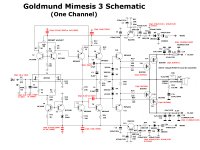Hi RC, can you also attach Myamp.txt
Thanks!
Hi
Please see post 36.
Your comments are welcome.
You can connect to the AC output that goes to BR's.
The thing is to connect positive side to the BR on positive side or you will get negative voltage because it's connected on "wrong side" of ground.
Figge
Hi Figge
Would you care to post a schematic ?
What are the BR ?
This is from the Crown DC300A schematic.
Some important points are:
1. C4 must be a SMALL capacitor in order to limit the current and therefore not waste a lot of power and heat.
2. D3 is a 10 Volt Zener tied from +60 to +70. This circuit adds 10V to the main 60V rail. It does not return to ground.
Be mindful that a high current supply is a huge waste. Estimate the IPS current draw and shunt no more than 2x that current. The shunt current in D3 is all that's needed and there is no added transistors. The problem is that while a voltage doubler allows stacking voltage on top of the main supply, it naturally generates too much voltage so you have to drop that voltage with a small capacitor in the AC and resistors in the DC. Note that if the doubler is overloaded, D3 becomes forward biased and the IPS voltage drops no lower than the main supply. Also note that a 10V Zener produces a lot less heat than a 50V - 70V shunt.
A more efficient circuit uses a ~3 Henry inductor in place of D1. That would make the circuit a half wave rectifier without voltage doubling. But, of course, large inductors are avoided when ever possible.
Hi steveu
Please see what I have in mind
Attachments
I suspect that C11 and C21 are bigger than they should be and that will mean you get a full 112VDC on C10 and C20, which is unnecessary and wasteful. Using a cap as a deliberate (AC) voltage drop is a means to avoid wasting power. Note that Crown used 22uF.
C10 and C20 can return to +56V and -56V instead of to ground, which means a 63V cap is enough.
Another 1n4004 from +56V to C9 and -56V to C19, guarantees the IPS voltage is at least as high as the OPS voltage.
C10 and C20 can return to +56V and -56V instead of to ground, which means a 63V cap is enough.
Another 1n4004 from +56V to C9 and -56V to C19, guarantees the IPS voltage is at least as high as the OPS voltage.
